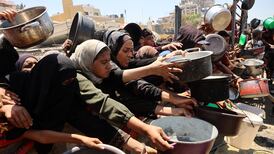Hurricane Eta, one of the most powerful storms to hit Central America in years, pummelled Nicaragua on Tuesday as it hit an impoverished region of the country's Caribbean coast, battering homes and infrastructure and threatening deadly floods.
Eta hit the shore near the port of Puerto Cabezas, pulling roofs off houses, knocking down trees and power lines, and causing flooding in the region, said Guillermo González, the head of Nicaragua's disaster management agency Sinapred.
The storm had been pounding the coast with high winds and rain since about midnight, Mr González told a news conference.
“We’re really afraid, there are fallen poles, there’s flooding, roofs torn off, some of the zinc on my house fell off,” said Carmen Enriquez, a resident of Puerto Cabezas.
“We spent the whole night up worrying, it hasn’t stopped raining, and they say it’s just starting,” she added.
The US National Hurricane Centre (NHC) said Eta is an "extremely dangerous" Category 4 storm on the five-step Saffir-Simpson scale, bringing "catastrophic winds" and flash flooding to Nicaragua and portions of Central America.
About 1,227,000 people in Nicaragua, including nearly 500,000 children, were at risk from the storm, the UN children's agency Unicef said in a statement.
By noon local time on Tuesday, Eta was blowing sustained winds of 225km/h as it slowly ground its way onshore south of Puerto Cabezas, the NHC said.
Honduras
In neighbouring Honduras, rivers burst their banks, towns and cities flooded on the Atlantic coast, and landslides hit roads.
Nicaraguan officials said there were still no reports of deaths or injuries. But in Honduras a 13-year-old girl died in a mudslide on her home in a barrio of the northern city of San Pedro Sula, which has been hammered by rain, authorities said.
The indigenous regions in Eta’s path in northern Nicaragua are some of the country’s poorest. Many people live in wooden homes that stand little chance against such a powerful storm.
Late on Monday, Fr Javier Plat, a local Catholic priest, told Reuters there was a citywide power outage in Puerto Cabezas and government-arranged shelters had reached capacity.
“This city of 70,000 people is very vulnerable. We have houses made of wood and adobe. The infrastructure of the residential houses is our main vulnerability,” Fr Plat said.
Nicaragua on Monday evacuated at least 3,000 families, including fishermen who live in the most vulnerable villages on the Atlantic coast, officials said. Some 20,000 people were taking cover in shelters, Sinapred said on Tuesday.
The storm is forecast to move inland over northern Nicaragua through Wednesday afternoon and then hit central Honduras on Thursday morning. Once it collides with the mountains of Nicaragua and Honduras, it should weaken rapidly, the NHC said.
Daniel Ortega’s government issued red alerts in several regions facing the hurricane.
El Salvador also evacuated citizens as a precaution.
Eta is the 28th named storm of the 2020 Atlantic hurricane season, tying an all-time record set in 2005, the NHC said. – Reuters











